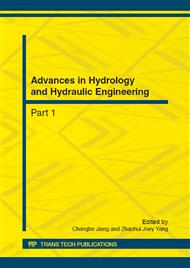p.1147
p.1151
p.1155
p.1161
p.1168
p.1172
p.1177
p.1182
p.1191
Solution to the Shallow Water Equation with FVM Based on Unstructured Grid
Abstract:
The diffusion motion is one of the important items in the shallow water equations, and it is a crucial factor for the stability to simulate the shallow water flow in the numerical model. In this paper, a 2D model for the simulation of shallow water flow by convection and diffusion over variable bottom is presented, which is based on the FVM (finite volume method) over triangular unstructured grids. The format of Reo’s approximate Riemann is adopted to solve the flux terms. And the bed slope source term is treated by split in the form of the flux eigenvector. For the diffusion terms, the divergence theorem is employed to obtain the derivatives of a scalar variable on each triangular cell. Then, the flow around a pillar is simulated, which flow pattern is similar with the actual flow. Thus it is proved that the model could be applied to simulate the complicated current structure in the water area around hydraulic construction.
Info:
Periodical:
Pages:
1168-1171
Citation:
Online since:
October 2012
Authors:
Price:
Сopyright:
© 2012 Trans Tech Publications Ltd. All Rights Reserved
Share:
Citation:


